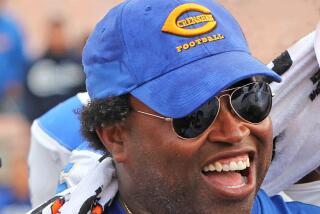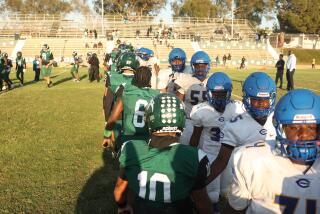SPORTS WEEKEND : Cards on the Table With Aces Showing : Crenshaw can’t hit the players’ shots for them, yet the onus is still on him, as captain, to produce a victory.
- Share via
BROOKLINE, Mass. — You don’t want to be Ben Crenshaw right now.
He has spent the last two years gearing up for this three-day tournament of the Ryder Cup. As the U.S. team captain, he has had input on everything from the length of the rough along the Country Club fairways to the style of the team’s uniforms.
Now the matches are here and once the ball is on the tee there’s not much more he can do except watch.
And that’s the hardest part.
While his counterpart on the European team, Mark James, has joked around like a man getting ready to take his boys on a fishing trip, Crenshaw looks as though he’s about to take final exams.
Crenshaw knows that, ultimately, it’s up to him to make things right.
The Americans have been “trending down” in recent years, as the corporate types descending on the Country Club this week would say. (Whatever happened to “declining”?) However you want to describe it, the fact is the United States has won only two of the last seven Ryder Cups.
Well, the U.S. team is a heavy favorite this time around. They shouldn’t lose. They can’t lose, right, Ben? Not with Tiger Woods and David Duval and Phil Mickelson and Davis Love III and a team so deep that guys like Justin Leonard and Mark O’Meara have to sit and wait to play.
Crenshaw is Phil Jackson coaching the Chicago Bulls with Michael Jordan; Pat Riley on the sidelines for the Showtime Lakers.
It is the blessing and the curse of a roster full of good players.
If his team wins, it will have to be a result of all that talent; if it loses, the coach must have blown it.
This wouldn’t be so hard for Crenshaw if he didn’t care so much. He played on four Ryder Cup teams from 1981 to 1995 and developed a deep appreciation for the event. He liked it better the old way, when the colors of the flag meant more than the figures on the paychecks. Back before the Ryder Cup wasn’t only an excuse to build hospitality tents all over a golf course.
Crenshaw loves history and tradition. The Country Club is sacred ground to him. The name itself epitomizes its almost Old World status. It’s not one of those something-ending-in-Wood country clubs. It’s the Country Club. As in, the original. Been here since 1894 and hosted its first U.S. Open in 1913.
“You cannot step on the grounds or come in these gates without knowing it’s a special historical place,” Crenshaw said.
There is personal history on this course for Crenshaw as well. He played here as a 16-year-old in the 1968 U.S. Junior Amateur.
“It was the formations of my really enjoying starting to study about the history of the game and studying [course] architecture,” Crenshaw said.
“To experience that when I did, when I was 16, really was a deep experience, so I have very emotional ties here.
“I find it very ironic that in the incubation process when I was here in 1968, to find that I’m captain here at such a meaningful proceeding is very, very meaningful. I’m highly honored.”
And highly concerned.
There really aren’t a tremendous number of strategic decisions for the captain to make once the competition is upon him. There are no timeouts to call, no adjustments in the middle of a round, no substituting in and out.
But those choices he does face can make him reach for the antacid, and leave him open to second-, third- and fourth-guessing.
Pick who plays and in which order. As of Thursday, that was all that remained on Crenshaw’s to-do list.
He had tailored the course to his preferences--as is the privilege of the host country’s captain--with short rough. He had made his two picks, with Steve Pate and Tom Lehman getting the nod. He quelled the pay-for-play controversy by giving a verbal smacking to his players in public and behind closed doors. Simply pick who plays and in which order.
Pair off eight of the 12 players for the alternate-shot foursomes, select another four pairs for the afternoon better-ball format played on Friday and Saturday, then select the lineup for Sunday’s singles matchups.
He must look at personalities and playing styles when choosing pairs. He must decide whether to front-load the lineup and hope to jump ahead or keep the best players for last in case it goes down to the wire.
Simple concepts, major implications. After the pairings for this morning’s foursomes were announced Thursday, the captains each held 30-minute news conferences to discuss them. Can you imagine a baseball manager spending half an hour talking about the order of his pitching rotation before the World Series?
It’s the Ryder Cup, so over-analysis is everywhere. And Crenshaw probably will be subjected to some amateur psychoanalysis before the weekend’s up.
Choosing the pairings and order of play is, in Crenshaw’s words “a very hard proposition,” “very difficult.” It’s something that, “for months and months I’ve struggled with.” They are what he must “wrestle” with. Crenshaw even sees problems in prosperity.
Of Woods, he said, “Tiger is just playing so well right now, it’s pretty difficult to put somebody together that you think that the two will blend.”
When you count a Tiger Woods in top form among your difficulties, that shows a high level of concern.
Crenshaw was asked when he will have a sense of relief.
“After it’s over.”
*
J.A. Adande can be reached at his e-mail address: j.a.adande@latimes.com.
More to Read
Go beyond the scoreboard
Get the latest on L.A.'s teams in the daily Sports Report newsletter.
You may occasionally receive promotional content from the Los Angeles Times.









